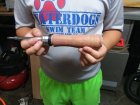My grandson had a gift certificate to WC. He picked out the ratcheting screwdriver. Tried to talk him into the ice cream scoop so he could use it when I visit. Wife is taking one of the kids to the orthodontist and he is coming over to work on this project Thursday. The instructions are on the fold-over label. It needs one 3/4 inch hole drilled to 1 inch deep. Then it takes a second hole 3/8 inch to a depth of 1-1/4 inch deep, giving a hole of 2-1/4 inches deep. I have some wood that could be used- cherry, purple heart, dogwood, Bradford pear (If I can figure out which one it is in the stack; need to label wood!). Here's what I'm thinking- round off the 2x2x6 stock and drill on the lathe. I have a pen chuck that would fit. Drill first carefully with a Forstner bit, change bits and carefully drill with a second Forstner bit? Since this could be used a lot.,. what finish would you recommend? Have BOL, CA, WOP. Thanks.
Link- https://www.woodcraft.com/products/7-function-ratcheting-screwdriver-turning-kit
Link- https://www.woodcraft.com/products/7-function-ratcheting-screwdriver-turning-kit



